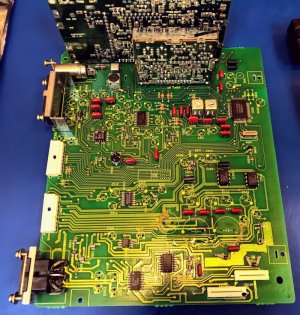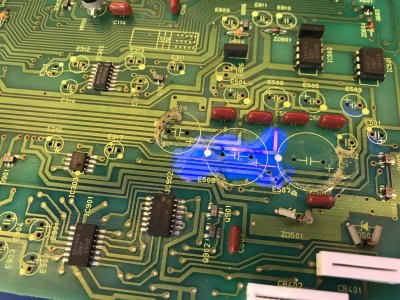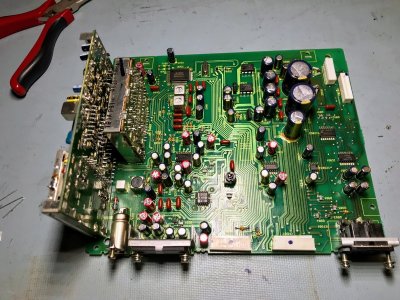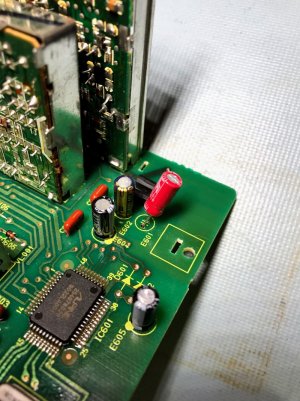I was having issues with my stereo sounding distorted for the first few minutes after it was turned on, and I suspected failing electrolytic capacitors like I found in my SRS unit and my fan control unit. This isn't an uncommon problem, as [MENTION=25737]Kaz-kzukNA1[/MENTION] has repaired several head units with much worse damage than what I found. For reference, he's got a whole category dedicated to fixing head units and amps. I was able to remove my head unit and disassemble it, using the following two videos as reference:
https://www.youtube.com/watch?v=8FoN7BBlJBw&list=PLpY4XKE12KVBQTn1mzz7lbpwDLq1Z6tmD&index=3
https://www.youtube.com/watch?v=5WnN9SiHP1M&list=PLpY4XKE12KVBQTn1mzz7lbpwDLq1Z6tmD&index=5
I'm glad I did, because the once I removed the bottom cover I was greeted with leaked electrolytic which was starting to eat the traces:
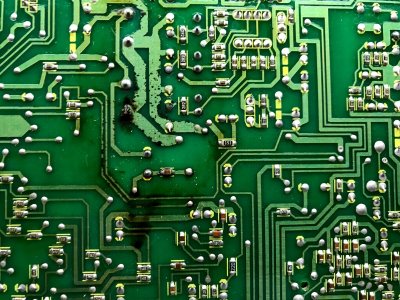
I decided at this point that it would be a good idea to go ahead and replace all the electrolytics in the head unit, since multiple caps were starting to leak and little (if any) damage had occurred yet. I would venture to say that this is going to happen to all NSX head units eventually, especially since all the caps were rated to 85°C. It would be best to get ahead of the problem and replace them before damage occurs, since repair of the PCB makes things even more difficult.
With that being said, I made a spreadsheet documenting the value, voltage, and lead spacing for all the electrolytics in the head unit. Over the next few weeks I'll add add pictures of the repair process, for anyone else who wants to tackle this job. I chose capacitors with preference to specs in this order: Value & Voltage, Lead spacing, AEC-Q200 (automotive) qualified, >105°C rating. In only one instance I was unable to find a part that was rated to at least 105°C, which is fine because all the original parts were 85°C anyways. I consulted with some EE's at work and they said it would probably be ok to replace the smaller values with ceramic caps, but some linear regulators and filters may depend on a minimum ESR for stability. I decided to err on the side of caution and choose all electrolytics again.
View attachment head_unit_caps_r4.xlsx
Digikey cart with parts in attached spreadsheet: http://www.digikey.com/short/qpjhbb
Be warned, there are 81 caps in the head unit, not including those in the AM tuner, FM tuner, and cassette player, all of which I negated due to laziness and\or difficulty of access. Keep in mind that my NSX is a 91, and Kaz has mentioned that the values were changed over the years. Additionally, there are several screws that need to be desoldered for the boards to be removed, as well as a ground tab on the FM tuner and the aux antenna lead. Here are some photos of the disassembly process:
After removing the top of the unit, with the top processor board, AM tuner card (second vertical from right) and FM tuner card (vertical at right) visible. I've documented all of the caps in this photo, excluding the tuner cards
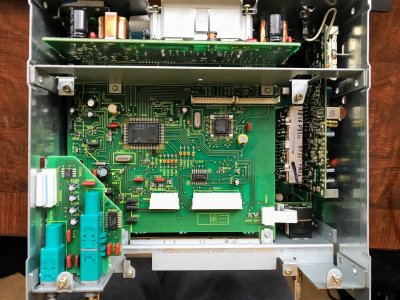
Bottom processor board, the location of ~50 of the 80 caps
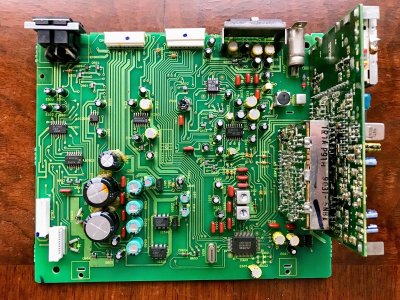
These three caps that seem to do most of the leaking. I believe they're potted down and only the center cap is leaking
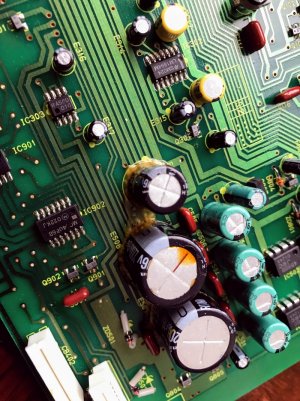
Caps in the AM tuner card that are difficult to get to, and I don't think I'm going to replace
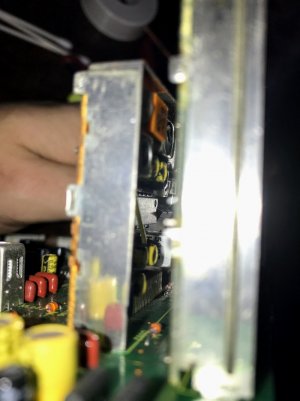
Caps on the FM tuner card which are also not getting replaced. They're not labeled, which would make documenting the process difficult.
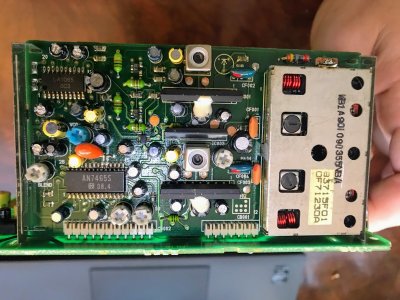
Caps in the tape deck which are difficult to get to.
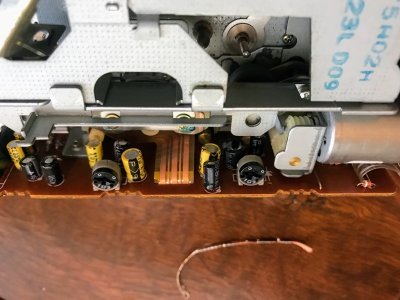
https://www.youtube.com/watch?v=8FoN7BBlJBw&list=PLpY4XKE12KVBQTn1mzz7lbpwDLq1Z6tmD&index=3
https://www.youtube.com/watch?v=5WnN9SiHP1M&list=PLpY4XKE12KVBQTn1mzz7lbpwDLq1Z6tmD&index=5
I'm glad I did, because the once I removed the bottom cover I was greeted with leaked electrolytic which was starting to eat the traces:

I decided at this point that it would be a good idea to go ahead and replace all the electrolytics in the head unit, since multiple caps were starting to leak and little (if any) damage had occurred yet. I would venture to say that this is going to happen to all NSX head units eventually, especially since all the caps were rated to 85°C. It would be best to get ahead of the problem and replace them before damage occurs, since repair of the PCB makes things even more difficult.
With that being said, I made a spreadsheet documenting the value, voltage, and lead spacing for all the electrolytics in the head unit. Over the next few weeks I'll add add pictures of the repair process, for anyone else who wants to tackle this job. I chose capacitors with preference to specs in this order: Value & Voltage, Lead spacing, AEC-Q200 (automotive) qualified, >105°C rating. In only one instance I was unable to find a part that was rated to at least 105°C, which is fine because all the original parts were 85°C anyways. I consulted with some EE's at work and they said it would probably be ok to replace the smaller values with ceramic caps, but some linear regulators and filters may depend on a minimum ESR for stability. I decided to err on the side of caution and choose all electrolytics again.
View attachment head_unit_caps_r4.xlsx
Digikey cart with parts in attached spreadsheet: http://www.digikey.com/short/qpjhbb
Be warned, there are 81 caps in the head unit, not including those in the AM tuner, FM tuner, and cassette player, all of which I negated due to laziness and\or difficulty of access. Keep in mind that my NSX is a 91, and Kaz has mentioned that the values were changed over the years. Additionally, there are several screws that need to be desoldered for the boards to be removed, as well as a ground tab on the FM tuner and the aux antenna lead. Here are some photos of the disassembly process:
After removing the top of the unit, with the top processor board, AM tuner card (second vertical from right) and FM tuner card (vertical at right) visible. I've documented all of the caps in this photo, excluding the tuner cards

Bottom processor board, the location of ~50 of the 80 caps

These three caps that seem to do most of the leaking. I believe they're potted down and only the center cap is leaking

Caps in the AM tuner card that are difficult to get to, and I don't think I'm going to replace

Caps on the FM tuner card which are also not getting replaced. They're not labeled, which would make documenting the process difficult.

Caps in the tape deck which are difficult to get to.

Last edited:








